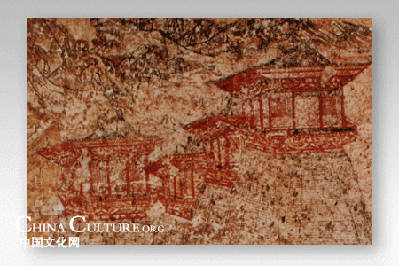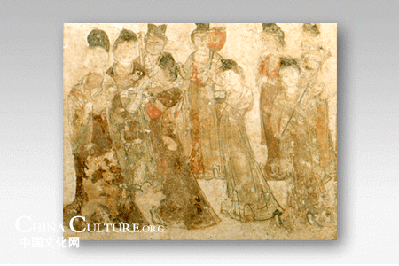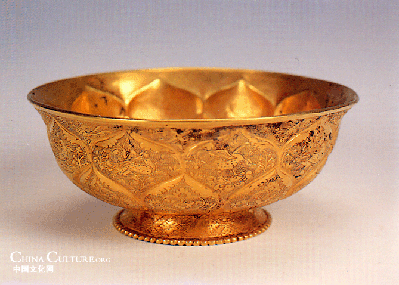7. Painting of Watchtowers

Age:Tang Dynasty
Height:280cm; Width:280cm
Unearthed in 1971 from tomb of Prince Yide, Qianxian County, Shaanxi Province
This painting was unearthed in the tomb of Prince Yide which is located on southeast of the Qian Mausoleum. Prince Yide was the eldest of Emperor Tang Zhongtong and grandson of he third Tang emperor, Gaozong and Emperess Wuzetian. He was sentenced to death at the age of 19 for opposing his grandmother’s autocracy.
Found on the east and west walls of the tomb passage, the paintings of watchtowers display the structure of Prince Yide’s graveyard. This is the piece on the west wall. According to traditional Chinese architectural principles, a large watchtower and two small watchtowers were arranged in "Three Watchtowers." Behind them, there are trees and mountains. On the right, the low building that looks like a watchtower is the gate tower of the city.
8. Painting of Palace Maids

Ages:Tang Dynasty
Height:176 cm Width:196.5 cm
Unearthed in 1960 from Princess Yongtai’s Tomb in Qianxian County, Shaanxi Province
Princess Yongtai was the seventh daughter of Emperor Tang Zhongzong and granddaughter of Emperor Tang Gaozong and Emperess Wuzetian. She was forced to kill herself at the age of 17 for opposing her grandmother’s autocracy.
This famous painting is on the southern side of the east wall in the front tomb chamber. There are nine palace maids in the painting. The first one is marching ahead gracefully with arms crossed on stomach. The one following her is turning back and seems to tell the rest what to do. The remaining seven maids carry a tray, a box, a candle, a round fan, a duster, a parcel and Ruyi respectively. All of them have vivid facial expression and are in the position to serve the Princess to sleep. These maids have exposed necks, and seven of them wear long skirts and shawl, while the other two girls wear men’s clothing. The appropriate composition, smooth lines and proper color make this fresco one of the national treasures of China.
9. Gold Bowl with Mandarin Ducks and Lotus Petals

Age: Tang Dynasty
Height:5.5cm; Diameter of Mouth:13.7cm; Diameter of Base:6.7cm
Unearthed in 1970 at Hejiacun, Xi’an
This bowl was hammered into shape. Outside is engraved with two layers of lotus petal designs, and each layer has ten petals. The upper layer was engraved with various designs: fox, rabbit, river deer, deer, parrot, Mandarin duck, flower and straw. The lower layer was decorated with honeysuckle. There is a rose carved on its inner base, and on its inner belly, there were three characters “Jiu Liang Ban” written in ink.
Two identical gold bowls alike were unearthed in 1970 at Hejiacun, Xi’an. On the outer surface is engraved with two layers of lotus petal designs and each layer has ten petals. There are different patterns engraved inside each lotus petal. In the lotus petals on the upper layer are engraved with animal patterns like Mandarin ducks, mallards, parrots and foxes. In the lotus petals on the lower layer are engraved with flowers and grass. Inside each bowl is written with three Chinese characters meaning the bowl weighs nine and a half liang (one Liang equals 50 grams).